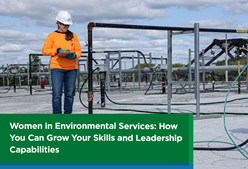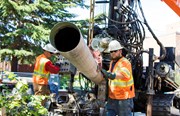How to Enhance Employee Retention Through Effective Onboarding
By: Jessica AlexanderOne of the biggest challenges that environmental field services companies face today isn’t recruiting top talent, but retaining it. No matter how effective or strategic your recruitment process may be, retaining employees is crucial to the continued success of your organization—and, on a larger scale, the environmental services industry as a whole. In this blog post, we’ll cover some key process improvement tools you can use to ensure your onboarding program is focused on retention and the continuous growth of your newly hired employees.
PREPARE MANAGERS FOR ONBOARDING
While this is arguably the most critical component of the onboarding process, it is often times overlooked. In the environmental services industry, our managers are heavily tasked and pulled in many directions. Operational managers and supervisors must be equipped with the tools they need to successfully onboard new employees.
These tools and resources may include:
- Checklists that cover important tasks, steps or training to be completed within a certain timeframe, such as being issued safety gear or being introduced to key staff
- Orientation videos that introduce the new employee to the company’s culture, mission, vision, values, and strategic direction
- Login information for key accounts that the new employee will need access to, along with guided instructions for how to utilize applications and software effectively
- New hire handbook that contains all relevant and necessary policy information that new hires should be aware of
- Points of contact within the organization for important matters such as information technology, human resources, payroll, and safety
SET EXPECTATIONS
While some newly hired employees may have familiarity with the environmental field services industry, many entry level employees will be completely new to the profession. For this reason, it’s important for new employees to have a solid understanding of what is expected of them in their new role. This goes beyond simply reading a job description. Effectively setting expectations involves continuous conversations centered around performance improvement and career development.
- Initial performance expectations should be established before an employee begins their new hire training.
- Performance feedback sessions should occur, at a minimum, at 30- and 90-days post-employment.
- Career conversations should be ongoing between a manager and his/her employee. These sessions are not just focused on performance but aimed towards understanding the employee’s motivations and the direction they’d like to see their career move in. These conversations are all about development and fostering a mutually beneficial relationship between the employee, the manager and the company.
LEVERAGE NEW HIRE TRAINING
The third tool is the new hire training program, which is where many organizations commonly lose new hire employees. While the training program itself must be tailored to your specific service line and organizational needs, the following basic factors surrounding the program should always be considered:
- Incorporating a summary of training, or training syllabus, to the new employee before training begins ensures they are adequately prepared for what lies ahead. This is particularly important in organizations where a training program extends beyond 1-2 weeks.
- Assigning a mentor to the new employee when he/she begins field-based training gives him/her direct access to an experienced, capable individual within the organization that can help guide and direct them on day to day tasks.
- Continuous assessment of the new hire training program is necessary to ensure it remains relevant (to both the company and the position) and provides new hires with the information and practical knowledge needed to be successful in their role.
GET FEEDBACK
Last, but certainly not least, you want to give your employees a voice throughout the onboarding process. Soliciting feedback via surveys or other methods is essential in evaluating the effectiveness of the onboarding process. Not only does this create a sense of trust and reassurance that the company truly cares about and values employees, but it also provides insight for the HR and leadership in understanding the program’s strengths and weaknesses.
When obtaining feedback regarding the onboarding process, it’s important to highlight areas where process improvement may be necessary. Remember, processes are rarely perfect the first time around. The important thing is to take feedback seriously and objectively, and seek ways in which you can make onboarding smoother and more effective for all members of the organization.
Field services workers have skill sets that make them highly desirable both in and outside the environmental services industry. By addressing these four areas of onboarding, you can provide a foundation for them to build a long and satisfying career in environmental services and at your organization.
Have a question for the author? Reach out to Talent Acquisition Manager, Jessica Alexander, at [email protected].






